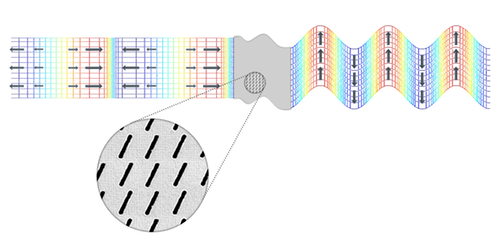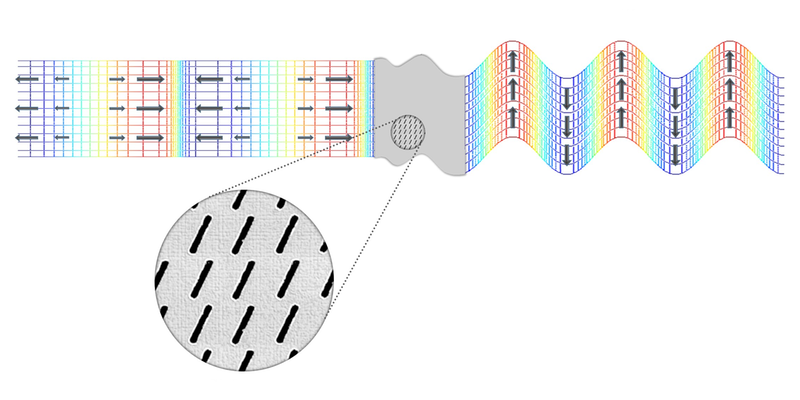Making Shear Waves for Ultrasonic Imaging
Ultrasound imaging could produce far better pictures with a different kind of sound wave. These higher-performing sound waves, so-called shear waves, are usually hard to generate, but now researchers have demonstrated a simple way to produce them. The team designed and tested a filter that transforms easy-to-generate pressure waves into shear waves more efficiently than previous devices. This filter can be easily fabricated with laser micromachining techniques and may lead to higher-resolution industrial and medical ultrasound imaging.
Normally, if waves traveling in one medium encounter a slab of a different medium, they cannot fully pass through. This lack of complete transmission leads to reduced resolution in ultrasonic imaging of the brain, for example, where high-frequency sound waves must penetrate the hard skull before reaching the soft tissue. Longitudinal (pressure) waves suffer this problem more severely than shear waves, the kind that deform the medium perpendicular to their direction of travel. Unfortunately, existing transducers—the devices that generate and sense the waves in ultrasound machines—can’t effectively produce shear waves.
Efforts to convert longitudinal to shear waves have involved sending the incoming waves through a wedge-shaped filter, which in the most recent examples was made from a metamaterial—a structure comprised of a repeating pattern of microscale, sound-scattering columns, for example. But the direction of the shear waves produced by one of these filters is very sensitive to fluctuations in the angle of the incoming waves, which can make the filter hard to use. Also, these filters cannot produce very high shear wave amplitudes, and they are difficult to manufacture.
Yoon Young Kim of Seoul National University in South Korea and his colleagues took a different approach, exploiting a new twist on a textbook phenomenon called Fabry-Pérot resonance (FPR). When sound waves travel through a slab of a medium different from its surroundings, they can be fully transmitted if the slab’s thickness is exactly a multiple of a half wavelength. This full transmission is caused by wave interference between the transmitted and reflected waves inside the slab. Kim and his colleagues found that with a metamaterial slab there can be a similar FPR condition that leads to maximum transmission of a shear wave when the input is a longitudinal wave.
The team developed a theory and supported it with numerical simulations and experiments. Their experiments used an aluminum plate containing a region (the metamaterial) where a series of 2-mm-long, parallel slits had been cut through the plate at an angle. When longitudinal ultrasound waves traveling down the plate hit these slits, some of their motion was transformed into shear waves. The amplitude of transmitted shear waves varied widely and periodically as the team increased the frequency of the incoming waves, as predicted. The angle and spacing of the slits also had a strong effect.
Kim and his colleagues accurately predicted a new FPR condition that maximizes shear wave transmission, but it involves two different wavelengths, one for each mode. For maximal transmission, the difference in progress between the two wave types (the accumulated phase difference) as they travel across the slit array should be equal to an odd number of half wavelengths. Under these ideal conditions, the data showed up to 80% efficiency for the conversion from longitudinal to shear waves.
Materials scientist Badreddine Assouar, at the French National Center for Scientific Research (CNRS) in Nancy, believes that the team’s novel expansion of a classical resonance theory could be useful for nondestructive testing of materials—looking for internal cracks in bridges or airplane wings, for example. Jensen Li, a materials scientist at the University of Birmingham, UK, notes that the converted shear waves can propagate long distances and adapt to curved surfaces without suffering much distortion. He says the results could lead to improved monitoring of gas pipelines for leaks, among other things; and the researchers “provide such an elegant condition to get maximal efficiency. The potential of such a scheme is huge.”
This research is published in Physical Review Letters.
–Rachel Berkowitz
Rachel Berkowitz is a Corresponding Editor for Physics Magazine based in Vancouver, Canada.





